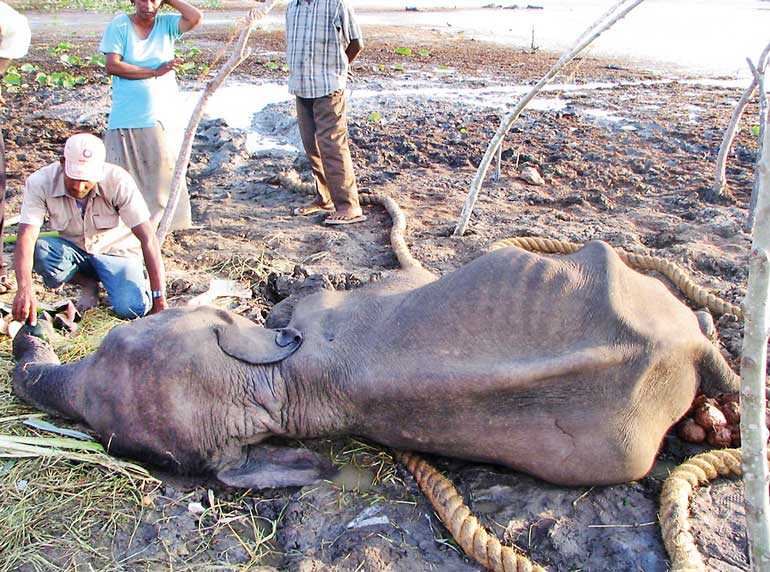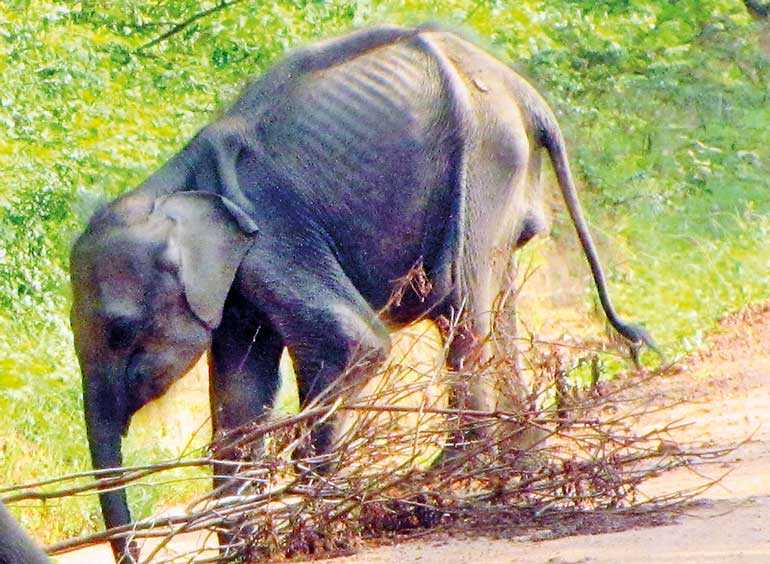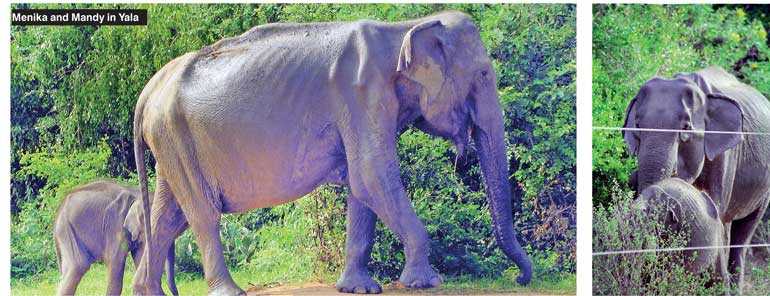Friday Oct 24, 2025
Friday Oct 24, 2025
Thursday, 2 August 2018 00:00 - - {{hitsCtrl.values.hits}}
 Kavan starving to death after being driven in and fenced inside Yala
Kavan starving to death after being driven in and fenced inside Yala

Baby starving to death after being driven to a park and fenced in
Every human life is precious, and every measure possible must be taken to preserve that life. Death, however, is also a part of life and, sometimes, happens suddenly and tragically, at the hands of Nature. These instances, too, may be reduced if there is proper understanding of how and why they take place. Study and research, over long periods of time, will provide the knowledge and measures necessary for reducing this number of casualties, though no measure can be completely successful for one of the wonders of Nature is her glorious unpredictability; for the natural world has evolved over millions of years and even the longest living human may only witness just a fraction, a fleeting moment, of its being, and can never have a complete conception of it.
Human-elephant conflict
Human-elephant conflict in Sri Lanka, too, needs to be seen in this context. In a population of approximately 22 million people, the average annual death rates caused by animals, and humans, on humans in Sri Lanka is as follows:
Tobacco related deaths ~ 20, 000 (55 per day)
Motor Vehicle Accidents ~ 9, 000
Suicides ~ 3, 600
Drownings ~ 1, 100
Train accidents – 514
Snake bites – 483
Mosquito related diseases (Dengue) – 421
Murders (Human on Human) – 358
Rat related diseases – 89
Elephants – 70 to 80
Pets /Strays (Rabies) – 12
In the backdrop of this, approximately 250-280 elephants, of a total population of approximately 6,000, also die, every year, due to the human-elephant conflict (HEC).
In Sri Lanka, humans and elephants have coexisted for centuries. In fact, today, despite the rapidly expanding human population, 70% of the total wild elephant population, estimated at approximately 6, 000 as per a 2011 survey, live outside of the Department of Wildlife Conservation (DWC) protected areas – in 60% of the land area of Sri Lanka. Over this time, and despite the increasing human population, and the fact that available space for elephants has shrunk due to loss of habitat to development, irrigation and infrastructure settlement, the actual number of human deaths has remained approximately the same – which is, in fact, a proportionate reduction in deaths over time. This is because the vast majority of elephants do not kill people. In fact, they avoid them as much as possible. It is just a few males, who are attracted to crops, who are the perpetrators. Most of human deaths from elephants occur at night when the unfortunate victim gets in the way of an elephant, many of which could be avoided by responsible behaviour by the victim. Most incidents of human – elephant conflict can be avoided with the implementation of the learnings from research, gleaned over many years.
A national management policy for wild elephants
There is just such a document in existence that has enshrined within it all of the strategies necessary to preserve the wild elephant populations of Sri Lanka for posterity, while ensuring that human deaths and losses from conflict are kept to a minimum. In 2006, the DWC, with the aid of experienced scientists, conservationists, and other relevant government agencies, devised a ‘National Policy for the Management of the Wild Elephant in Sri Lanka’. This document was passed by Cabinet and gazette, but never implemented in full. It was revised in 2017, in consultation with multiple stakeholders, and presented to the Ministry for re-presentation to Cabinet. This has never happened; an enormous pity as apart from strategies to prevent HEC, this had within it proposed measure to stop the illegal capture of baby elephants from the wild, and that electric fences should be placed on ecological boundaries and NOT on administrative boundaries between DWC and Forest Department (FD) lands. DWC and FD lands, in these areas, are contiguous habitats ideal for elephants.
A fundamental component in the HEC strategy (proposed in 2006 and re-stated in 2017) was that it established that electric fences were the best method available, at present, to prevent elephants from entering areas that they should not be in. As the main purpose is to protect people, it proposes that communities in areas with elephant conflict should be helped to protect their villages and cultivations with electric fences. Electric fences protecting villages should be permanent structures while those protecting seasonal cultivations such as paddy only being deployed during cultivation and removed after the harvest, thereby not requiring constant maintenance. An added bonus was that elephants could now enter to feed off the stubble and use the uncultivated fields for their movement from place to place without conflict with people. These community-based fences have been piloted in over 30 villages in the North Western and Eastern regions, has been successful, and is partly paid for and fully maintained by the villagers themselves. They have set up ‘Fence Committees’ and function cooperatively to protect their investment. It works – a cooperative endeavour that is financially and administratively sustainable for the long-term – and makes life safer for both human and elephant!
Of course, giving villagers such empowerment to determine their own fates does not sit well with politicians who prefer to create dependency, and then keep to themselves the right of ‘gifting’ economic assistance to these rural communities – in exchange for votes, of course.
The revised Policy now sits on a shelf in the Ministry, and under the present administration, is likely to never see the light of day again. However, till the revised version is approved, the Policy in effect is the 2006 Policy.

Declaring war on wild elephants
There is a new regime at the Ministry of Wildlife, installed in office just two months ago, with no previous experience or empathy for the subject of conservation. At a public forum organised by the Department of Wildlife Conservation, the new Minister for Wildlife announced that rather than take the advice of researchers and conservationists, and implement the National Policy, that he had devised a policy of his own, for a ‘final solution’ to HEC, by adding 2,500 km of electric fencing to the existing 4,500 km, and confining elephants to forested land, by driving them from all places where they have contact with humans. In addition, he announced that 3,500 members of the Civil Defence Force (CDF) will be suitably armed, with Chinese weapons similar to T56 rifles, and placed at regular intervals along the fence to restrict the elephants to where they have been driven to. Suitable ‘guard posts’ will be built, at regular intervals along the fences, for the members of the CDF who will function independently and NOT be under the jurisdiction of the DWC.
As there are villages and cultivations in 60% of the landscape of Sri Lanka in which 70% of the elephant population of Sri Lanka live, if the aforementioned estimate of numbers is to be accepted, then almost 4,000 elephants will have to be driven – but to where? The only places left would be the protected areas without people which constitute just 18% of the land area of the island and are at carrying capacity for elephants i.e. there is no more food for any additional elephants! Exceeding the carrying capacity would result in elephants starving to death due to a lack of adequate fodder.
In addition, the Minister is to increase the number of elephants brought to the Elephant Holding Facility at Horowpathana to 100 elephants, and build another at Lunugamvehera. To these ‘prisons’, according to the Minister, will be sent all male elephants that are caught habituating human cultivation. As this population contain many of the prime breeding bulls in Sri Lanka, the genetic health of future populations, if there are any, will be serious weakened.
And then these captives will have to be fed!
It is indeed an irony that this declaration of war on the elephant population of Sri Lanka is made by the person who has been appointed as their Protector and Guardian.
Driving out the enemy
One of the main motivations for the new policy that was developed in 2006 was that for decades the DWC had been trying to drive elephants into protected areas but completely failed. Research has revealed that when elephant drives are undertaken it is only some of the herds consisting of females and young that can be driven, whereas most of the males and especially the problem causing males remain. While elephant drives have been conducted in Sri Lanka for many decades, there isn’t a single area where elephants have been eliminated by such drives. Driving elephants, means confronting them and subjecting them to intense conflict including shooting with live ammunition day after day for weeks, months sometimes more than a year. When elephants are subjected to such prolonged and intense conflict they become extremely aggressive towards people. Since many elephants subject to drives remain in areas with people, the human-elephant conflict becomes severe. However these past events would seem like a kindergarten tussle compared to the aftermath of the island-wide drives that would need to be undertaken to achieve the ‘final solution’.
Starving the enemy
An elephant needs 100-300 kg of fodder a day to survive, which it picks and chooses feeding for 17-19 hours a day just to survive. Therefore elephants require large areas to sustain them and it requires around 10 square km of mature forest to support a single elephant while 1 square km of savannah-grassland vegetation can support about three elephants. However, whatever the natural habitat in Sri Lanka it already has the number of elephants it can support – called the carrying capacity. Driving elephants out of their home ranges into forests that have elephants, and restricting them there, causes exceeding of the carrying capacity and those driven in and those already there starve to death. This is already seen in the Yala and Lunugamvehera National Parks where elephants have been driven in and electric fences have been placed on administrative boundaries and the elephants that once could roam freely between Forest Department (FD) and DWC lands, now have to rely solely on what there is within the Park. Researchers have found that over 54% of babies born to the herds within the Yala National Park die due to starvation!
The Minister does recognise that food will be a problem and proposes that 10,000 acres of DWC forests are cut to grow grasslands to feed elephants! This is an astounding proposal, that the guardian agency for biodiversity conservation, particularly of wildlife and protected areas, cut its own forests, sacrificing the lives of the other forest dependent fauna and flora who live there, to grow grasslands! This is a project that will require a huge amount of resources and has proven unsustainable where tried in the Dry Zone, where water is at a premium, and vital for the growing of grass! Also the main requirement for food is in the dry season and growing grass in the dry zone of Sri Lanka in the dry season is like building castles in the sky. This also hardly sits well with the President’s declaration at the current environmental forum in Rome that Sri Lanka is determined to increase its forests cover to 32%! In addition, based on documented research data, 10,000 acres of grassland (even if magically created) can provide fodder requirements for less than 100 elephants! There will be 4,000 that will have to exist on what is not enough for 100.
The Minister proposes that Rs. 1 billion is utilised from DWC’s Wildlife Preservation Fund and that Rs. 250 million a year is spent on feeding the elephants in the ‘prison’ at Horowpathana! He is also clear that his only ambition is to serve in this capacity until the next elections, 18 months hence, and that he will ensure that his plans are carried out in this time. This is not conservation ‘but’ politics…and elephants, wild and political, will pay the price for his endeavour!
There is money to be made in wildlife
An expenditure of Rs. 1 billion over 18 months! Thousands of kilometres of electric fencing material to be purchased, fences to be erected, hundreds of guard posts to be built, Chinese high-powered rifles to be purchased, and timber from 10,000 acres of forest…there is much profit in store for a few from this venture…an investment, over a period of 18 months, for a few hundred votes!
Yet, wild animals, by just being wild and free, and without any payment of commission, earn this country billions of rupees of revenue every year. It is estimated that the Yala National Park alone earns Rs. 7.5 billion for the local economy every year, and that the famous ‘Gathering’ of elephants at Minneriya earns that region Rs. 1.5 billion in just the few months of its happening. Tourists flock to see wild elephants, wild animals, and not those who have been pushed into enclosures, starved and emaciated, and have to be fed just to stay alive!
The last hope
Every life is precious, and every measure possible must be taken to preserve that life; even the life of a wild animal. Seasoned scientists and researchers, with experienced officers of the DWC, and other government agencies, have made a policy that will save the lives of humans and elephants and ensure their continued coexistence in the landscapes of Sri Lanka. What is needed is someone who will give leadership to implement this policy; to uphold the Law of the Land. Declaring elephants as the enemy and pushing them behind lines of engagement is not the solution; that is politics – short-term politics. Hundreds or thousands of elephants will die a slow death. It would be kinder to shoot them. Ah, but that would be against the whole culture and philosophy of this country. But starving them to death; that would be fine! Is this to be the legacy of this political regime?